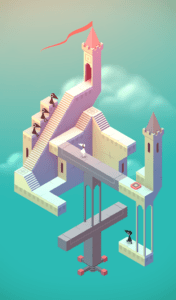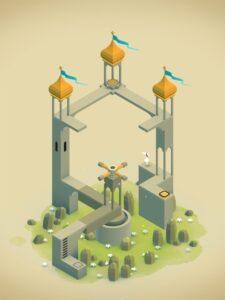About the Game
 This week I played the critically acclaimed puzzle game Monument Valley on my iPhone. The game was first released in 2014 on iOS by the indie game studio Ustwo Games, and it continues to have a significant cultural impact to this day. The game’s standout feature undeniably lies in its breathtaking visuals and animation style which draw inspiration from artists such as M. C. Escher. As a result, the intended audience for this game is undoubtedly made up of individuals who value a game’s artwork more than the gameplay experience.
This week I played the critically acclaimed puzzle game Monument Valley on my iPhone. The game was first released in 2014 on iOS by the indie game studio Ustwo Games, and it continues to have a significant cultural impact to this day. The game’s standout feature undeniably lies in its breathtaking visuals and animation style which draw inspiration from artists such as M. C. Escher. As a result, the intended audience for this game is undoubtedly made up of individuals who value a game’s artwork more than the gameplay experience.
The mechanics of each level are extremely basic: players are shown an optical illusion-style building and the objective is to get the character Princess Ida from her starting position to an ending spot somewhere else on the building. To do this, players can tap and swipe on the building to interact with it or rotate their view of it. The mechanics encourage players to explore and experiment with the environment, discovering hidden paths and uncovering new perspectives. The puzzle aspect of the game comes from the fact that the buildings are disorienting and intricately constructed, making it difficult to visualize the path that Princess Ida can take from one spot to another. It’s through the player’s tapping, dragging, and pinching that the puzzle not only is solved, but initially is revealed. Monument Valley is unique in this way — a level may look extremely simple at first, but its complexity will eventually be uncovered through the player’s interaction with the building.
Since the game visuals are so foreign, I believe it’s important that the mechanics are so familiar and intuitive. This balance keeps the gameplay both engaging and immersive, ensuring that players can easily interact with this surrealist fantasy world and solve the puzzles.
![]()
[ rotating a building can make pathways appear to connect from the
player’s new perspective, thus allowing Princess Ida to move across it ]
Why It’s Fun!
This game relies heavily on sensation (probably more so than the vast, vast majority of games). In addition to being incredibly visually appealing, there’s also an atmospheric and ethereal soundtrack that further enhances the experience. However, since it is a puzzle game at its core, it also relies on challenge as players attempt to solve each level through problem solving and critical thinking. Finally, I believe that Monument Valley derives fun through submission since very little thought is needed in order to solve each level, and the music/visuals can be quite meditative. I would argue that the game is quite successful in its pursuit of these sources of fun, and I found myself revisiting the app even after I had played it for enough time to write this review.
How It Could Be ~ Better ~
 Although I enjoyed playing this game, I do have some serious critiques. The game tries to introduce a narrative surrounding Princess Ida and her motivation for needing to navigate through these strange buildings, but it never fully flushes it out. This narrative aspect felt tacked on rather than built into the game from the first stages of development — I believe the game would be much stronger if the creators had put a lot more thought into this element. Additionally, the game does have an element of challenge but it’s not very difficult. I understand the emphasis on the artwork rather than the gameplay, but they could build in a ‘zen mode’ and a ‘competitive mode’ so that players who only want to play to look at the level designs could have one play style and players who want a more challenging game could have another.
Although I enjoyed playing this game, I do have some serious critiques. The game tries to introduce a narrative surrounding Princess Ida and her motivation for needing to navigate through these strange buildings, but it never fully flushes it out. This narrative aspect felt tacked on rather than built into the game from the first stages of development — I believe the game would be much stronger if the creators had put a lot more thought into this element. Additionally, the game does have an element of challenge but it’s not very difficult. I understand the emphasis on the artwork rather than the gameplay, but they could build in a ‘zen mode’ and a ‘competitive mode’ so that players who only want to play to look at the level designs could have one play style and players who want a more challenging game could have another.




